Richard Knight in “Vultures of Silence” by Donald E. Keyhoe
THE unstoppable Donald E. Keyhoe 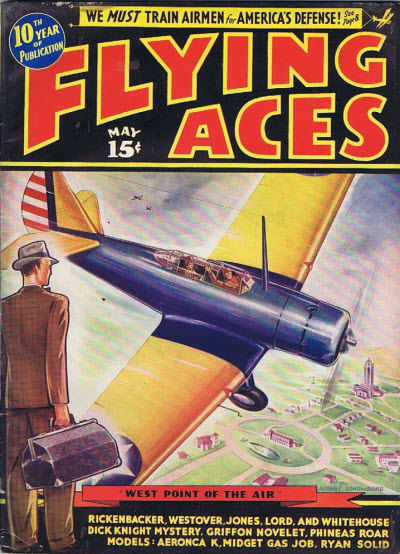 had a story in a majority of the issue of Flying Aces from his first in January 1930 until he returned to the Navy in 1942. Starting in August 1931, they were stories featuring the weird World War I stories of Philip Strange. But in November 1936, he began alternating these with sometime equally weird present day tales of espionage Ace Richard Knight—code name Agent Q. After an accident in the Great War, Knight developed the uncanny ability to see in the dark. Aided by his skirt-chasing partner Larry Doyle, Knights adventures ranged from your basic between the wars espionage to lost valley civilizations and dinosaurs. Secret agents from a dozen countries have all rushed into the Mediterranean for something—but what? Knight and Doyle set out to find out just what it could be. The carrier from which they’ve just taken off mysteriously and soundlessly explodes leaving nothing behind! Just what is out there?
had a story in a majority of the issue of Flying Aces from his first in January 1930 until he returned to the Navy in 1942. Starting in August 1931, they were stories featuring the weird World War I stories of Philip Strange. But in November 1936, he began alternating these with sometime equally weird present day tales of espionage Ace Richard Knight—code name Agent Q. After an accident in the Great War, Knight developed the uncanny ability to see in the dark. Aided by his skirt-chasing partner Larry Doyle, Knights adventures ranged from your basic between the wars espionage to lost valley civilizations and dinosaurs. Secret agents from a dozen countries have all rushed into the Mediterranean for something—but what? Knight and Doyle set out to find out just what it could be. The carrier from which they’ve just taken off mysteriously and soundlessly explodes leaving nothing behind! Just what is out there?
Toward grim Gibraltar, Dick Knight sped his sleek Vought. For Europe’s craftiest spies were hurrying into that caldron of intrigue just beyond “The Rock”—and Washington’s orders had been terse: “Find out why”! But already that sinister sea was red with the blood of rash agents who had ventured too far. And already it was too late for Dick Knight to turn back. For he had defied muted murder—had defied “The Death that had no face”!
Richard Knight in “Hell Hammers Harbin” by Donald E. Keyhoe
THE prolific Donald E. Keyhoe 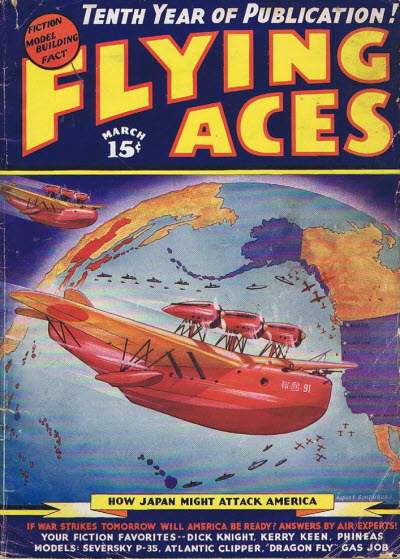 had a story in a majority of the issue of Flying Aces from his first in January 1930 until he returned to the Navy in 1942. Starting in August 1931, they were stories featuring the weird World War I stories of Philip Strange. But in November 1936, he began alternating these with sometime equally weird present day tales of espionage Ace Richard Knight—code name Agent Q. After an accident in the Great War, Knight developed the uncanny ability to see in the dark. Aided by his skirt-chasing partner Larry Doyle, Knights adventures ranged from your basic between the wars espionage to lost valley civilizations and dinosaurs.
had a story in a majority of the issue of Flying Aces from his first in January 1930 until he returned to the Navy in 1942. Starting in August 1931, they were stories featuring the weird World War I stories of Philip Strange. But in November 1936, he began alternating these with sometime equally weird present day tales of espionage Ace Richard Knight—code name Agent Q. After an accident in the Great War, Knight developed the uncanny ability to see in the dark. Aided by his skirt-chasing partner Larry Doyle, Knights adventures ranged from your basic between the wars espionage to lost valley civilizations and dinosaurs.
“Hell Hammers Harbin” from the pages of the March 1938 issue of Flying Aces is Keyhoe’s ninth story with the intrepid Q-Agent and his pal Larry Doyle.
North! North! And still farther northward over those bleak wastes of Asia flew Dick Knight. His course was uncharted—his destination unknown even to himself! Only a question mark—a cryptic crimson question mark emblazoned on a rough Manchurian map—offered a clue to the mystery of that mad flight. And that puny clue was destined to be his single weapon against—hideous meteors of murder!
Richard Knight vs “Aces of Death” by Donald E. Keyhoe
THE prolific Donald E. Keyhoe 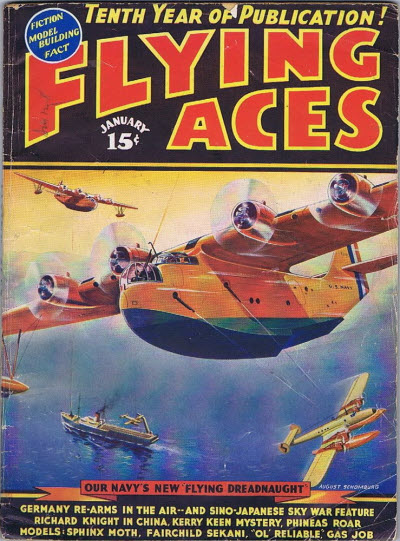 had a story in a majority of the issue of Flying Aces from his first in January 1930 until he returned to the Navy in 1942. Starting in August 1931, they were stories featuring the weird World War I stories of Philip Strange. But in November 1936, he began alternating these with sometime equally weird present day tales of espionage Ace Richard Knight—code name Agent Q. After an accident in the Great War, Knight developed the uncanny ability to see in the dark. Aided by his skirt-chasing partner Larry Doyle, Knights adventures ranged from your basic between the wars espionage to lost valley civilizations and dinosaurs.
had a story in a majority of the issue of Flying Aces from his first in January 1930 until he returned to the Navy in 1942. Starting in August 1931, they were stories featuring the weird World War I stories of Philip Strange. But in November 1936, he began alternating these with sometime equally weird present day tales of espionage Ace Richard Knight—code name Agent Q. After an accident in the Great War, Knight developed the uncanny ability to see in the dark. Aided by his skirt-chasing partner Larry Doyle, Knights adventures ranged from your basic between the wars espionage to lost valley civilizations and dinosaurs.
“Aces of Death” from the pages of the January 1938 issue of Flying Aces is Keyhoe’s eight story with the intrepid Q-Agent and his pal Larry Doyle.
What infernal power had loosed those gun-bristling Grummans upon stricken China? And who were the merciless white devils who flew them like madmen and who fought like fiends? This sinister riddle called for the unfailing skill of Richard Knight. But even that ace agent was balked. For the winged killer from whom he sought to wrest its answer leaped into the flaming inferno of his own fallen plane—gave vent in his death throes to a defiant scream of triumph.
Richard Knight faces “Hell Over China” by Donald E. Keyhoe
THE prolific Donald E. Keyhoe 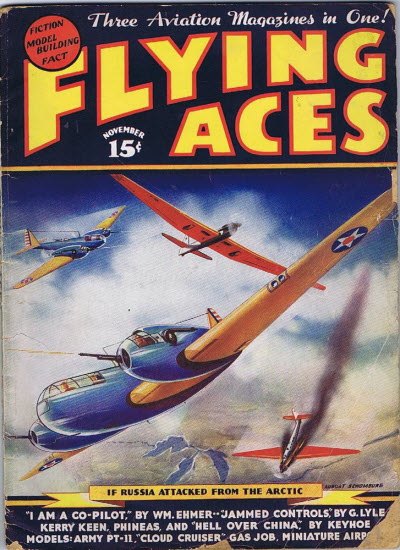 had a story in a majority of the issue of Flying Aces from his first in January 1930 until he returned to the Navy in 1942. Starting in August 1931, they were stories featuring the weird World War I stories of Philip Strange. But in November 1936, he began alternating these with sometime equally weird present day tales of espionage Ace Richard Knight—code name Agent Q. After an accident in the Great War, Knight developed the uncanny ability to see in the dark. Aided by his skirt-chasing partner Larry Doyle, Knights adventures ranged from your basic between the wars espionage to lost valley civilizations and dinosaurs. In their seventh outing from the pages of the November 1937 issue of Flying Aces, Knight and Doyle are sent to China and find themselves embroiled in a dramatic oriental sky mystery confronted by a death-ray that destroys all in it’s path! Can Agent “Q” avoid a mutated death within that eerie ray as he faces “Death Over China!”
had a story in a majority of the issue of Flying Aces from his first in January 1930 until he returned to the Navy in 1942. Starting in August 1931, they were stories featuring the weird World War I stories of Philip Strange. But in November 1936, he began alternating these with sometime equally weird present day tales of espionage Ace Richard Knight—code name Agent Q. After an accident in the Great War, Knight developed the uncanny ability to see in the dark. Aided by his skirt-chasing partner Larry Doyle, Knights adventures ranged from your basic between the wars espionage to lost valley civilizations and dinosaurs. In their seventh outing from the pages of the November 1937 issue of Flying Aces, Knight and Doyle are sent to China and find themselves embroiled in a dramatic oriental sky mystery confronted by a death-ray that destroys all in it’s path! Can Agent “Q” avoid a mutated death within that eerie ray as he faces “Death Over China!”
On the twisted body of that ruthless killer they had gunned from the skies, Richard Knight found an ominous message. “I will call again,” those brush-written characters announced, and appended was the dread symbol of Mo-Gwei—the sign of “The Devil”! Then “muted death” whipped across those gloomy heavens to fulfill that satanic threat. And as the shattered bodies of wretched airmen plunged to the earth, there came an infernal laugh. The cone of silence had found new victims!
Richard Knight in “Wings of the Emerald” by Donald E. Keyhoe
THE unstoppable Donald E. Keyhoe 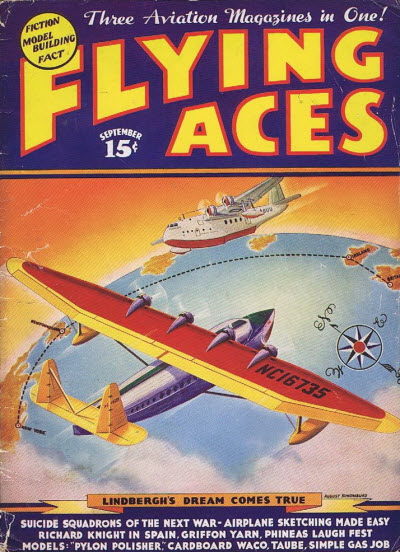 had a story in a majority of the issue of Flying Aces from his first in January 1930 until he returned to the Navy in 1942. Starting in August 1931, they were stories featuring the weird World War I stories of Philip Strange. But in November 1936, he began alternating these with sometime equally weird present day tales of espionage Ace Richard Knight—code name Agent Q. After an accident in the Great War, Knight developed the uncanny ability to see in the dark. Aided by his skirt-chasing partner Larry Doyle, Knights adventures ranged from your basic between the wars espionage to lost valley civilizations and dinosaurs. Still in Spain, Richard Knight heads back into war-torn Spain in an effort to retrieve the Green Madonna—only to find The Hawk has kidnapped Benita Navarre!
had a story in a majority of the issue of Flying Aces from his first in January 1930 until he returned to the Navy in 1942. Starting in August 1931, they were stories featuring the weird World War I stories of Philip Strange. But in November 1936, he began alternating these with sometime equally weird present day tales of espionage Ace Richard Knight—code name Agent Q. After an accident in the Great War, Knight developed the uncanny ability to see in the dark. Aided by his skirt-chasing partner Larry Doyle, Knights adventures ranged from your basic between the wars espionage to lost valley civilizations and dinosaurs. Still in Spain, Richard Knight heads back into war-torn Spain in an effort to retrieve the Green Madonna—only to find The Hawk has kidnapped Benita Navarre!
Through those blood-red skies that hung like the hand of Doom over war-wracked Spain, there swooped a winged, incarnate devil—a greedy ghoul men called “The Hawk.” Sparing neither Rebel nor Loyalist, this eerie fiend struck without warning. Wretched Iberia herself was his victim; ruthlessly he pounced upon her, and from her defenseless form his merciless talons tore priceless treasures. And now those bony claws clutched the gleaming “Green Madonna”—sought to wrench from that brilliant jewel a secret known only to Death.
Richard Knight in “Masks Over Madrid” by Donald E. Keyhoe
THE unstoppable Donald E. Keyhoe 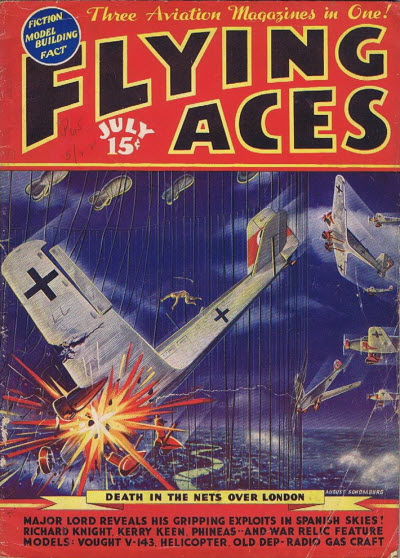 had a story in a majority of the issue of Flying Aces from his first in January 1930 until he returned to the Navy in 1942. Starting in August 1931, they were stories featuring the weird World War I stories of Philip Strange. But in November 1936, he began alternating these with sometime equally weird present day tales of espionage Ace Richard Knight—code name Agent Q. After an accident in the Great War, Knight developed the uncanny ability to see in the dark. Aided by his skirt-chasing partner Larry Doyle, Knights adventures ranged from your basic between the wars espionage to lost valley civilizations and dinosaurs. Knight is sent to Spain to get the American military men out of the Spanish Cival War, only to find the mysterious Four Faces—a criminal cabal that seek to control all crime on the earth—trying to turn La Guerra Civil into another World War with America taking all the blame!
had a story in a majority of the issue of Flying Aces from his first in January 1930 until he returned to the Navy in 1942. Starting in August 1931, they were stories featuring the weird World War I stories of Philip Strange. But in November 1936, he began alternating these with sometime equally weird present day tales of espionage Ace Richard Knight—code name Agent Q. After an accident in the Great War, Knight developed the uncanny ability to see in the dark. Aided by his skirt-chasing partner Larry Doyle, Knights adventures ranged from your basic between the wars espionage to lost valley civilizations and dinosaurs. Knight is sent to Spain to get the American military men out of the Spanish Cival War, only to find the mysterious Four Faces—a criminal cabal that seek to control all crime on the earth—trying to turn La Guerra Civil into another World War with America taking all the blame!
Above those barrage – battered buildings of Madrid, vengeful Heinkels had hemmed in a lone flyer, were pouncing in for the kill. Fascinated, Richard Knight stared up at that grim drama, saw the doomed airman cast from his lead-flailed cockpit an oddly-fashioned chest bound to the chute that would have saved him. But when Richard Knight pried the lid from that strange box, he halted, transfixed. Inside was naught but a yellowed human skull! Why had a man given his life for this?
Richard Knight in “Falcons from Nowhere” by Donald E. Keyhoe
THE unstoppable Donald E. Keyhoe 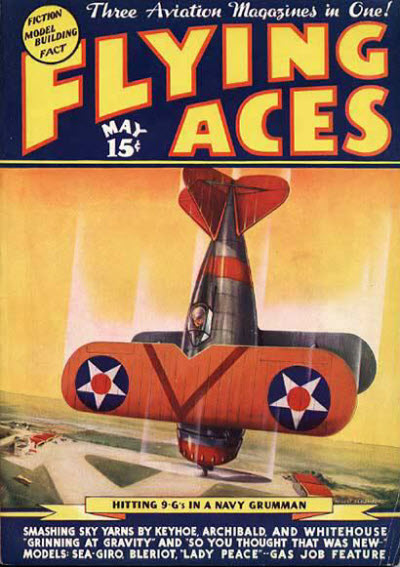 had a story in a majority of the issue of Flying Aces from his first in January 1930 until he returned to the Navy in 1942. Starting in August 1931, they were stories featuring the weird World War I stories of Philip Strange. But in November 1936, he began alternating these with sometime equally weird present day tales of espionage Ace Richard Knight—code name Agent Q. After an accident in the Great War, Knight developed the uncanny ability to see in the dark. Aided by his skirt-chasing partner Larry Doyle, Knights adventures ranged from your basic between the wars espionage to lost valley civilizations and dinosaurs. The mysterious Four Faces—a criminal cabal that seek to control all crime on the earth—has found a way to turn people to stone, which comes in handy while they continue to build their air fleet of stolen ships!
had a story in a majority of the issue of Flying Aces from his first in January 1930 until he returned to the Navy in 1942. Starting in August 1931, they were stories featuring the weird World War I stories of Philip Strange. But in November 1936, he began alternating these with sometime equally weird present day tales of espionage Ace Richard Knight—code name Agent Q. After an accident in the Great War, Knight developed the uncanny ability to see in the dark. Aided by his skirt-chasing partner Larry Doyle, Knights adventures ranged from your basic between the wars espionage to lost valley civilizations and dinosaurs. The mysterious Four Faces—a criminal cabal that seek to control all crime on the earth—has found a way to turn people to stone, which comes in handy while they continue to build their air fleet of stolen ships!
Through the growing twilight sped a powerful Northrop, and from its front pit peered Richard Knight. He saw no other ship in the sky; the secret of their mission was safe. But Richard Knight was unaware that an unseen hand was reaching through that descending pall to tear away an invisible veil—to loose upon him a hideous fate that had never before been faced by man. That fate was the ‘doom of stone’—and it had been streaming across the boundless wastes of eternity since the dawn of time.
Richard Knight in “Death Flies The Equator” by Donald E. Keyhoe
THE unstoppable Donald E. Keyhoe 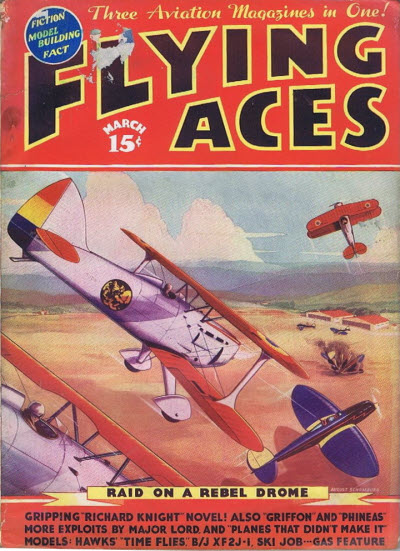 had a story in a majority of the issue of Flying Aces from his first in January 1930 until he returned to the Navy in 1942. Starting in August 1931, they were stories featuring the weird World War I stories of Philip Strange. But in November 1936, he began alternating these with sometime equally weird present day tales of espionage Ace Richard Knight—code name Agent Q. After an accident in the Great War, Knight developed the uncanny ability to see in the dark. Aided by his skirt-chasing partner Larry Doyle, Knights adventures ranged from your basic between the wars espionage to lost valley civilizations and dinosaurs. In this, his third adventure, Knight and Doyle come up against the mysterious Four Faces—a criminal cabal that seek to control all crime on the earth.
had a story in a majority of the issue of Flying Aces from his first in January 1930 until he returned to the Navy in 1942. Starting in August 1931, they were stories featuring the weird World War I stories of Philip Strange. But in November 1936, he began alternating these with sometime equally weird present day tales of espionage Ace Richard Knight—code name Agent Q. After an accident in the Great War, Knight developed the uncanny ability to see in the dark. Aided by his skirt-chasing partner Larry Doyle, Knights adventures ranged from your basic between the wars espionage to lost valley civilizations and dinosaurs. In this, his third adventure, Knight and Doyle come up against the mysterious Four Faces—a criminal cabal that seek to control all crime on the earth.
A haunted look came over the Admiral’s face. “That lost Wapiti,” he told Knight, “was found high on the beach at Crazy Day Atoll—that tiny mid-Pacific dot lying exactly at the point where East meets West, and North meets South. Underneath the island’s single palm tree sat the pilot and observer. Their bodies were stark as in death—yet they still lived! Their eyes were open—but they were eyes which only stared unseeing over the broad wastes of the sea.”
“Hell Flies High” by Donald E. Keyhoe
THE unstoppable Donald E. Keyhoe 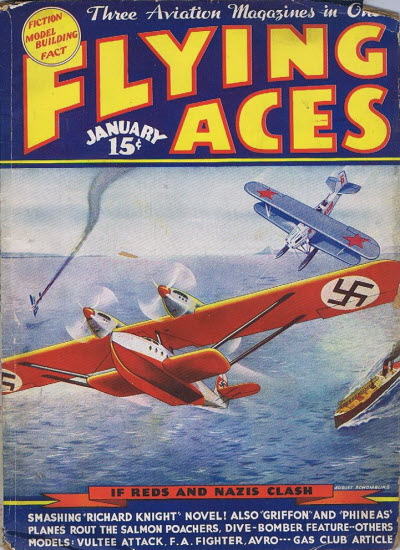 had a story in a majority of the issue of Flying Aces from his first in January 1930 until he returned to the Navy in 1942. Starting in August 1931, they were stories featuring the weird World War I stories of Philip Strange. But in November 1936, he began alternating these with sometime equally weird present day tales of espionage Ace Richard Knight—code name Agent Q. After an accident in the Great War, Knight developed the uncanny ability to see in the dark. Aided by his skirt-chasing partner Larry Doyle, Knights adventures ranged from your basic between the wars espionage to lost valley civilizations and dinosaurs. This, his second tale from January 1937, is more espionage than lost civilizations (like his first).
had a story in a majority of the issue of Flying Aces from his first in January 1930 until he returned to the Navy in 1942. Starting in August 1931, they were stories featuring the weird World War I stories of Philip Strange. But in November 1936, he began alternating these with sometime equally weird present day tales of espionage Ace Richard Knight—code name Agent Q. After an accident in the Great War, Knight developed the uncanny ability to see in the dark. Aided by his skirt-chasing partner Larry Doyle, Knights adventures ranged from your basic between the wars espionage to lost valley civilizations and dinosaurs. This, his second tale from January 1937, is more espionage than lost civilizations (like his first).
“Washington to Gray, Flight Eight . . . Washington to Gray . . . Report your position . . .†No sooner had that message rung across those leaden skies when just ahead of his speeding Northrop Richard Knight glimpsed a huge Douglas transport roaring through the snowy blur. And as he saw that ship he cringed. Gray had reported for the last time. For out of that craft’s windows there stared dilated, terrified eyes—the unseeing eyes of the dead. And the faces from which they peered were—a hideous green!
Editor’s Note: His first story, Vultures of the Lost Valley (November 1936, Flying Aces) can be found here.
“Hell’s Hangar” by Donald E. Keyhoe
Save for some strange, organ-like trills that had sounded from his radio, Dick Knight’s flight had been uneventful. But Knight did not know that those weird tones he had heard were the ominous notes of an overture to a drama of death. Nor did he know that just five minutes before, a gaunt Prussian, with feverish eyes on a black clock, had whispered: “Five more minutes! Only five more minutes to wait after all these years!â€
“Vultures of the Lost Valley” by Donald E. Keyhoe
In the November 1936 issue of Flying Aces, Donald E. Keyhoe introduced Richard Knight, ace pilot and secret agent of the U.S. government. Along with his dame-chasing assistant Larry Doyle, he confronts evil-doers around  the world, flying his specially equipped (and heavily armed) blue Northrup.
Down upon the flood-lit Washington Airport came a sleek Douglas transport. And from it ran a strangely costumed girl wielding a glittering dagger in spirited attempts to protect herself from the burly men who sought to stop her. Only the lightning decision of a tall, well-built man in a car on the driveway saved her. That man was Richard Knight. And this surprising incident was destined to send him upon the most startling adventure of his career—an adventure which, wholly unknown to him, had begun more than half a century before he was born.
 had a story in a majority of the issue of Flying Aces from his first in January 1930 until he returned to the Navy in 1942. Starting in August 1931, they were stories featuring the weird World War I stories of Philip Strange. But in November 1936, he began alternating these with sometime equally weird present day tales of espionage Ace Richard Knight—code name Agent Q. After an accident in the Great War, Knight developed the uncanny ability to see in the dark. Aided by his skirt-chasing partner Larry Doyle, Knights adventures ranged from your basic between the wars espionage to lost valley civilizations and dinosaurs. Secret agents from a dozen countries have all rushed into the Mediterranean for something—but what? Knight and Doyle set out to find out just what it could be. The carrier from which they’ve just taken off mysteriously and soundlessly explodes leaving nothing behind! Just what is out there?
had a story in a majority of the issue of Flying Aces from his first in January 1930 until he returned to the Navy in 1942. Starting in August 1931, they were stories featuring the weird World War I stories of Philip Strange. But in November 1936, he began alternating these with sometime equally weird present day tales of espionage Ace Richard Knight—code name Agent Q. After an accident in the Great War, Knight developed the uncanny ability to see in the dark. Aided by his skirt-chasing partner Larry Doyle, Knights adventures ranged from your basic between the wars espionage to lost valley civilizations and dinosaurs. Secret agents from a dozen countries have all rushed into the Mediterranean for something—but what? Knight and Doyle set out to find out just what it could be. The carrier from which they’ve just taken off mysteriously and soundlessly explodes leaving nothing behind! Just what is out there?




 had a story in a majority of the issue of Flying Aces from his first in January 1930 until he returned to the Navy in 1942. Starting in August 1931, they were stories featuring the weird World War I stories of Philip Strange. But in November 1936, he began alternating these with sometime equally weird present day tales of espionage Ace Richard Knight—code name Agent Q. After an accident in the Great War, Knight developed the uncanny ability to see in the dark. Aided by his skirt-chasing partner Larry Doyle, Knights adventures ranged from your basic between the wars espionage to lost valley civilizations and dinosaurs.
had a story in a majority of the issue of Flying Aces from his first in January 1930 until he returned to the Navy in 1942. Starting in August 1931, they were stories featuring the weird World War I stories of Philip Strange. But in November 1936, he began alternating these with sometime equally weird present day tales of espionage Ace Richard Knight—code name Agent Q. After an accident in the Great War, Knight developed the uncanny ability to see in the dark. Aided by his skirt-chasing partner Larry Doyle, Knights adventures ranged from your basic between the wars espionage to lost valley civilizations and dinosaurs.  had a story in a majority of the issue of Flying Aces from his first in January 1930 until he returned to the Navy in 1942. Starting in August 1931, they were stories featuring the weird World War I stories of Philip Strange. But in November 1936, he began alternating these with sometime equally weird present day tales of espionage Ace Richard Knight—code name Agent Q. After an accident in the Great War, Knight developed the uncanny ability to see in the dark. Aided by his skirt-chasing partner Larry Doyle, Knights adventures ranged from your basic between the wars espionage to lost valley civilizations and dinosaurs.
had a story in a majority of the issue of Flying Aces from his first in January 1930 until he returned to the Navy in 1942. Starting in August 1931, they were stories featuring the weird World War I stories of Philip Strange. But in November 1936, he began alternating these with sometime equally weird present day tales of espionage Ace Richard Knight—code name Agent Q. After an accident in the Great War, Knight developed the uncanny ability to see in the dark. Aided by his skirt-chasing partner Larry Doyle, Knights adventures ranged from your basic between the wars espionage to lost valley civilizations and dinosaurs.  had a story in a majority of the issue of Flying Aces from his first in January 1930 until he returned to the Navy in 1942. Starting in August 1931, they were stories featuring the weird World War I stories of Philip Strange. But in November 1936, he began alternating these with sometime equally weird present day tales of espionage Ace Richard Knight—code name Agent Q. After an accident in the Great War, Knight developed the uncanny ability to see in the dark. Aided by his skirt-chasing partner Larry Doyle, Knights adventures ranged from your basic between the wars espionage to lost valley civilizations and dinosaurs. In their seventh outing from the pages of the November 1937 issue of Flying Aces, Knight and Doyle are sent to China and find themselves embroiled in a dramatic oriental sky mystery confronted by a death-ray that destroys all in it’s path! Can Agent “Q” avoid a mutated death within that eerie ray as he faces “Death Over China!”
had a story in a majority of the issue of Flying Aces from his first in January 1930 until he returned to the Navy in 1942. Starting in August 1931, they were stories featuring the weird World War I stories of Philip Strange. But in November 1936, he began alternating these with sometime equally weird present day tales of espionage Ace Richard Knight—code name Agent Q. After an accident in the Great War, Knight developed the uncanny ability to see in the dark. Aided by his skirt-chasing partner Larry Doyle, Knights adventures ranged from your basic between the wars espionage to lost valley civilizations and dinosaurs. In their seventh outing from the pages of the November 1937 issue of Flying Aces, Knight and Doyle are sent to China and find themselves embroiled in a dramatic oriental sky mystery confronted by a death-ray that destroys all in it’s path! Can Agent “Q” avoid a mutated death within that eerie ray as he faces “Death Over China!” had a story in a majority of the issue of Flying Aces from his first in January 1930 until he returned to the Navy in 1942. Starting in August 1931, they were stories featuring the weird World War I stories of Philip Strange. But in November 1936, he began alternating these with sometime equally weird present day tales of espionage Ace Richard Knight—code name Agent Q. After an accident in the Great War, Knight developed the uncanny ability to see in the dark. Aided by his skirt-chasing partner Larry Doyle, Knights adventures ranged from your basic between the wars espionage to lost valley civilizations and dinosaurs. Still in Spain, Richard Knight heads back into war-torn Spain in an effort to retrieve the Green Madonna—only to find The Hawk has kidnapped Benita Navarre!
had a story in a majority of the issue of Flying Aces from his first in January 1930 until he returned to the Navy in 1942. Starting in August 1931, they were stories featuring the weird World War I stories of Philip Strange. But in November 1936, he began alternating these with sometime equally weird present day tales of espionage Ace Richard Knight—code name Agent Q. After an accident in the Great War, Knight developed the uncanny ability to see in the dark. Aided by his skirt-chasing partner Larry Doyle, Knights adventures ranged from your basic between the wars espionage to lost valley civilizations and dinosaurs. Still in Spain, Richard Knight heads back into war-torn Spain in an effort to retrieve the Green Madonna—only to find The Hawk has kidnapped Benita Navarre! had a story in a majority of the issue of Flying Aces from his first in January 1930 until he returned to the Navy in 1942. Starting in August 1931, they were stories featuring the weird World War I stories of Philip Strange. But in November 1936, he began alternating these with sometime equally weird present day tales of espionage Ace Richard Knight—code name Agent Q. After an accident in the Great War, Knight developed the uncanny ability to see in the dark. Aided by his skirt-chasing partner Larry Doyle, Knights adventures ranged from your basic between the wars espionage to lost valley civilizations and dinosaurs. Knight is sent to Spain to get the American military men out of the Spanish Cival War, only to find the mysterious Four Faces—a criminal cabal that seek to control all crime on the earth—trying to turn La Guerra Civil into another World War with America taking all the blame!
had a story in a majority of the issue of Flying Aces from his first in January 1930 until he returned to the Navy in 1942. Starting in August 1931, they were stories featuring the weird World War I stories of Philip Strange. But in November 1936, he began alternating these with sometime equally weird present day tales of espionage Ace Richard Knight—code name Agent Q. After an accident in the Great War, Knight developed the uncanny ability to see in the dark. Aided by his skirt-chasing partner Larry Doyle, Knights adventures ranged from your basic between the wars espionage to lost valley civilizations and dinosaurs. Knight is sent to Spain to get the American military men out of the Spanish Cival War, only to find the mysterious Four Faces—a criminal cabal that seek to control all crime on the earth—trying to turn La Guerra Civil into another World War with America taking all the blame! had a story in a majority of the issue of Flying Aces from his first in January 1930 until he returned to the Navy in 1942. Starting in August 1931, they were stories featuring the weird World War I stories of Philip Strange. But in November 1936, he began alternating these with sometime equally weird present day tales of espionage Ace Richard Knight—code name Agent Q. After an accident in the Great War, Knight developed the uncanny ability to see in the dark. Aided by his skirt-chasing partner Larry Doyle, Knights adventures ranged from your basic between the wars espionage to lost valley civilizations and dinosaurs. The mysterious Four Faces—a criminal cabal that seek to control all crime on the earth—has found a way to turn people to stone, which comes in handy while they continue to build their air fleet of stolen ships!
had a story in a majority of the issue of Flying Aces from his first in January 1930 until he returned to the Navy in 1942. Starting in August 1931, they were stories featuring the weird World War I stories of Philip Strange. But in November 1936, he began alternating these with sometime equally weird present day tales of espionage Ace Richard Knight—code name Agent Q. After an accident in the Great War, Knight developed the uncanny ability to see in the dark. Aided by his skirt-chasing partner Larry Doyle, Knights adventures ranged from your basic between the wars espionage to lost valley civilizations and dinosaurs. The mysterious Four Faces—a criminal cabal that seek to control all crime on the earth—has found a way to turn people to stone, which comes in handy while they continue to build their air fleet of stolen ships!  had a story in a majority of the issue of Flying Aces from his first in January 1930 until he returned to the Navy in 1942. Starting in August 1931, they were stories featuring the weird World War I stories of Philip Strange. But in November 1936, he began alternating these with sometime equally weird present day tales of espionage Ace Richard Knight—code name Agent Q. After an accident in the Great War, Knight developed the uncanny ability to see in the dark. Aided by his skirt-chasing partner Larry Doyle, Knights adventures ranged from your basic between the wars espionage to lost valley civilizations and dinosaurs. In this, his third adventure, Knight and Doyle come up against the mysterious Four Faces—a criminal cabal that seek to control all crime on the earth.
had a story in a majority of the issue of Flying Aces from his first in January 1930 until he returned to the Navy in 1942. Starting in August 1931, they were stories featuring the weird World War I stories of Philip Strange. But in November 1936, he began alternating these with sometime equally weird present day tales of espionage Ace Richard Knight—code name Agent Q. After an accident in the Great War, Knight developed the uncanny ability to see in the dark. Aided by his skirt-chasing partner Larry Doyle, Knights adventures ranged from your basic between the wars espionage to lost valley civilizations and dinosaurs. In this, his third adventure, Knight and Doyle come up against the mysterious Four Faces—a criminal cabal that seek to control all crime on the earth. had a story in a majority of the issue of Flying Aces from his first in January 1930 until he returned to the Navy in 1942. Starting in August 1931, they were stories featuring the weird World War I stories of Philip Strange. But in November 1936, he began alternating these with sometime equally weird present day tales of espionage Ace Richard Knight—code name Agent Q. After an accident in the Great War, Knight developed the uncanny ability to see in the dark. Aided by his skirt-chasing partner Larry Doyle, Knights adventures ranged from your basic between the wars espionage to lost valley civilizations and dinosaurs. This, his second tale from January 1937, is more espionage than lost civilizations (like his first).
had a story in a majority of the issue of Flying Aces from his first in January 1930 until he returned to the Navy in 1942. Starting in August 1931, they were stories featuring the weird World War I stories of Philip Strange. But in November 1936, he began alternating these with sometime equally weird present day tales of espionage Ace Richard Knight—code name Agent Q. After an accident in the Great War, Knight developed the uncanny ability to see in the dark. Aided by his skirt-chasing partner Larry Doyle, Knights adventures ranged from your basic between the wars espionage to lost valley civilizations and dinosaurs. This, his second tale from January 1937, is more espionage than lost civilizations (like his first).